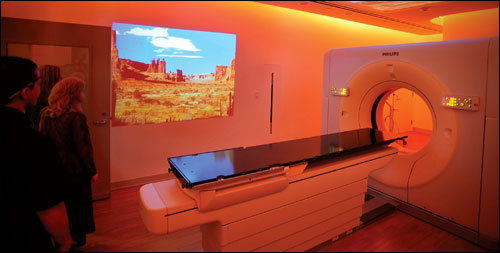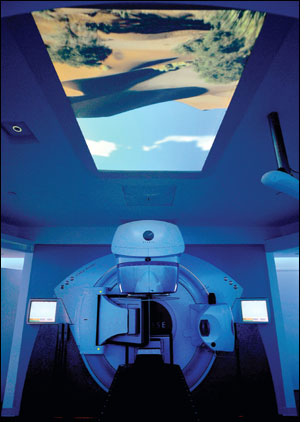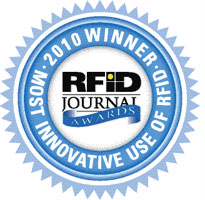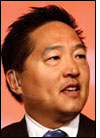Jun 01, 2010On Apr. 19, 2010, RFID Journal presented the fourth annual RFID Journal Awards for outstanding achievement in radio frequency identification technology to four companies at RFID Journal LIVE! 2010, our eighth annual conference and exhibition. This year's winner for Most Innovative Use of RFID was the Roy and Patricia Disney Family Cancer Center.
Cancer patients have to contend not only with a potentially life-threatening disease, but often with loss of control of their physical appearance, schedules and finances as well. That's why one of the main objectives for the $55 million Roy and Patricia Disney Family Cancer Center, which opened in February at the Providence Saint Joseph Medical Center, in Burbank, Calif., was to reduce patient anxiety. Staff members wanted to create a facility that would provide excellent medical care and restore a measure of control to patients, by allowing them to manage their treatment experience.
In 2005, the medical center, part of a 27-hospital chain of Providence Health & Services, a not-for-profit health system based in Renton, Wash., established a steering committee from diverse departments—including information technology, biomedical engineering, facilities management and oncology—to define a vision for the 55,000-square-foot cancer center. The committee identified several additional objectives: create a spa-like setting incorporating elements of nature; improve workflow among clinicians, patients and administrators; and maximize return on investment by building a technology infrastructure that could evolve and scale up over time, according to Ray Lowe, IS director for the medical center and a steering committee member.
The overall goal was to make each visit as easy as possible for patients. "We know if patients are more relaxed, they'll have better clinical outcomes," says Tamara Sutton, the medical center's service area director for oncology, and a steering committee member.
The gleaming state-of-the-art outpatient facility, on the hospital's Burbank campus, takes a holistic approach to cancer treatment, to heal the body, mind and spirit of patients from across the San Fernando Valley. It offers both Eastern and Western therapies, including chemotherapy, radiation, acupuncture, nutrition counseling, massage and yoga. The building features a rooftop healing garden, waterfall, reflecting pool, library and personal-appearance boutique where patients can purchase wigs, prosthetics and other items they may need to cope with the side effects of treatment.
Key to improving the overall patient experience is a radio frequency identification patient-tracking system designed to personalize each visit. It helps staffers prepare for each patient, and lets the patient control the lighting, temperature, music and scenery in the treatment rooms.
From Vision to Reality
In late 2006, the steering committee hired Johnson Controls as systems integrator and project manager for the medical center's RFID patient-tracking system. No systems existed like the one planned for the Disney Family Cancer Center, according to Tamer Reda, a Johnson Controls regional sales manager who worked on the project. "This project was unique," he says. "We didn't model it on anything. It's a concept based on the vision of the clinical staff. They wanted an environment that was familiar and comfortable to patients, where patients felt at home."

Unlike many hospitals that first deploy RFID to track assets for cost cutting, the Providence Saint Joseph Medical Center had never used the technology before implementing the patient-tracking application at the cancer center. "This project was really about the patient experience," Reda says. "This wasn't built around a return on investment. That's rare."
Each patient is issued an identification badge, which can be attached to a lanyard and worn around the neck or carried in a pocket or bag. The badge is embedded with an Alien Technology EPC Gen 2 RFID inlay that carries a unique identification number. No health information is written on the tag—all that's included is the ID number, which is associated with the patient's medical records stored in a back-end database. All patient files are electronic, which required integration of records from multiple sources, including doctors, pharmacy, scheduling, laboratories and billing.
When patients enter the building, two ThingMagic Astra ceiling-mounted interrogators in the lobby read their tags, and information, including their names and schedules for the day, is instantly transmitted to a concierge's computer screen. The concierge can then greet patients by name and direct them to their appointments. "The fact that someone knows your name and knows what you are there for makes a big difference," Sutton says.
When patients first visit some of the treatment rooms, a staff member helps them customize the environment to their liking. They can choose the room temperature, from 60 to 85 degrees Fahrenheit, and one of six music selections, from rock to easy listening. Patients can also choose the room lighting—red, blue or orange—and opt to have beach, mountain or desert scenes displayed on the walls.

The staffer uses an AMX Touch Panel to input the patient's choices, which are stored in the security database. When patients enter the treatment rooms for subsequent appointments, the system reads their tags and activates their preferred settings. The reception among patients to these features has been overwhelmingly positive, Lowe says. "Their reaction is 'Wow! This is cool,'" he says. "They certainly appreciate it."
Singular Focus
Given the project's complex technology infrastructure, numerous challenges arose during development. From a project management perspective, one of the toughest was getting all the technology vendors aligned around the hospital's vision for the project, according to Reda. "Building consensus was the most challenging aspect," he says. Keeping all the disparate players focused on the same goal required extensive communication.
When it came to implementation, integrating patient records from multiple sources with other systems—including RFID, the VoIP phone network and the building's environmental controls—was complex. "We integrated 35 different systems," Lowe says. "It was quite challenging, but it works."
Center personnel gradually introduced the patient-tracking application to groups of patients, and by early April, the system was handling about 40 percent of patient volume. Once fully operational, the RFID system will track 2,500 to 3,000 patients, Sutton says.
Over time, the hospital expects the tag data to provide visibility into workflow and other processes that may need improvement. The information can also help with capacity and staff planning, she adds.
The medical center is considering expanding the use of RFID to track infusion pumps, as well as for temperature and humidity sensing and control. Adding active RFID for these applications would be relatively easy, since the infrastructure is already in place to accommodate it, Lowe says.
In the future, the medical center would like to use the RFID location information to study the effect of Eastern therapies, such as yoga or acupuncture, on long-term health. But for now, giving patients some control over the treatment process eases an often difficult and painful experience. "This environment gives you the feeling that it's all about you," Sutton says. "It's all about your choices."


